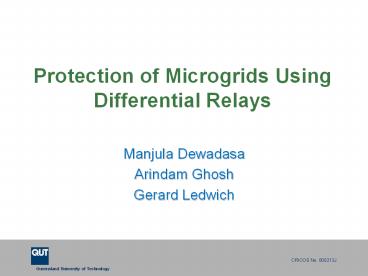Protection of Microgrids Using Differential Relays - PowerPoint PPT Presentation
Title:
Protection of Microgrids Using Differential Relays
Description:
Protection of Microgrids Using Differential Relays Manjula Dewadasa Arindam Ghosh Gerard Ledwich Introduction Protection Issues A microgrid integrates distributed ... – PowerPoint PPT presentation
Number of Views:1377
Avg rating:3.0/5.0
Title: Protection of Microgrids Using Differential Relays
1
Protection of Microgrids Using Differential Relays
- Manjula Dewadasa
- Arindam Ghosh
- Gerard Ledwich
2
Introduction Protection Issues
- A microgrid integrates distributed energy
resources to provide reliable, environment
friendly and economical power - A microgrid can operate either in grid-connected
or islanded mode - Islanding operation brings benefits to customers
- However, once islanding occurs, short circuit
levels may drop significantly due to the absence
of strong utility grid - In this case, protection system designed for high
fault currents will not respond and new
protection strategies are required to ensure a
safe islanding operation in a microgrid
3
Protection Issues Contd.
- The power flow within a microgrid can be
bi-directional due to - DG connections at different locations
- mesh configuration
- Most of DGs are connected through power
electronic converters and these converters do not
supply sufficient currents to operate current
based protective devices - Some of the DGs connected to a microgrid are
intermittent and therefore different fault
current levels can be experienced - Protecting a converter dominated microgrid is a
challenging technical issue
4
Protection Solutions
- Protection strategies required for a microgrid
are presented using current deferential relays - The protection challenges associated with
- bi-directional power flow
- meshed configuration
- changing fault current level due to intermittent
nature of DGs - reduced fault current level in an islanded mode
- are addressed
5
Microgrid Configuration
- Protection of the microgrid is discussed under
different subgroups such as feeder, bus and DG
Link
6
Differential Feeder Protection
- Current differential protection is proposed to
detect and isolate the feeder faults
The differential and bias currents are defined as
I1 and I2 are secondary CT phasor currents in
each relay location
7
Deferential Relay Characteristic
- In normal operating condition, the differential
current should be zero - However, due to the line charging, CT saturation
and inaccuracies in CT mismatch, it may not equal
to zero
8
Deferential Bus Protection
- Buses may have connected to loads, DGs and
feeders - The relay will issue a trip command to all the
circuit breakers connected to the bus during a
bus fault
9
CT Selection Criteria for Protection
- IEEE C57.13 and IEEE C37.11provide guidelines in
selecting CTs for protective relays - Following factors should be considered
- CT ratio
- CT accuracy class
- polarity
- saturation voltage
- knee point voltage
- excitation characteristic
- primary side voltage rating and current rating
10
CT Selection Criteria Contd.
- IEEE C57.13 and IEEE C37.11provide guidelines in
selecting CTs for protective relays - Usually, the secondary rated current is 5A
- The primary current rating of a CT is selected
considering - the maximum current in normal operating condition
- the maximum symmetrical fault current
- The selected primary current should be greater
than the maximum current in normal operating
condition and it should also be greater than one
twentieth (1/20) of the maximum symmetrical fault
current
11
CT Selection Criteria Contd.
- The saturation due to both AC and DC components
can be avoided by selecting the saturation
voltage of a CT according to
Vx - secondary saturation voltage IS - the ratio
between the primary current and the CT turns
ratio RS - the CT secondary resistance XL - the
leakage reactance ZB - the total secondary burden
which includes secondary leads and devices X -
the primary system reactance R - the resistance
up to the fault point
12
Microgrid Protection Studies
- The CT ratio for a particular CT is selected
based on the maximum load current and the maximum
fault current seen by the relay. - The CT ratio for a relay is selected based on
- the CT can deliver 20 times rated secondary
current without exceeding 10 ratio error - the rated primary current to be above the maximum
possible load current
13
Simulation Results
Relay Ifmax (A) Ifmax/20 (A) ILmax (A) CT ratio
R12 2535 126 236 3005
R21 1478 74 236 3005
R15 2541 127 236 3005
R51 956 48 236 3005
R25 1111 56 184 2005
R52 998 50 184 2005
R23 1478 74 142 1505
R32 917 46 142 1505
R34 917 46 79 1005
R43 654 33 79 1005
- The maximum CT ratio error of 10 is assumed
14
Simulation Results Contd.
- The fault response of relays R23 and R32 for
internal and external feeder faults
The fault resistance is varied from 1 ? to 20 ?
15
Simulation Results Contd.
- The fault response of relays R23 and R32 for
internal and external feeder faults
16
Relay Response in Islanded Operation
- Relays R12 and R21 response for faults in
islanded microgrid
- Relays are capable of detecting faults either in
grid connected or islanded modes of operation
without changing any relay settings
17
Conclusions
- In this paper, a primary protection scheme for a
microgrid is presented using current differential
relays - The protection issues associated with meshed
structure, microgrid islanded operation, fault
detection under low fault current levels are
avoided with the use of modern differential
relays - Relay settings and CT selection requirements are
also discussed - Results show that the proposed protection
strategies can provide selectivity and high level
of sensitivity for internal faults in both
grid-connected and islanded modes of operation
thereby allowing a safe and a reliable operation
for a microgrid
18
Thank You































